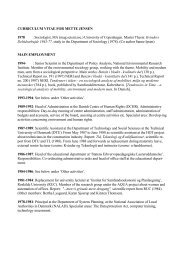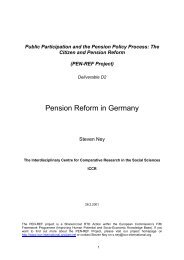The Housing Dimension of Welfare Reform - the ICCR
The Housing Dimension of Welfare Reform - the ICCR
The Housing Dimension of Welfare Reform - the ICCR
Create successful ePaper yourself
Turn your PDF publications into a flip-book with our unique Google optimized e-Paper software.
like, for instance, <strong>the</strong> gini coefficient tapping on <strong>the</strong> general level <strong>of</strong><br />
inequality in a society – are always relevant for <strong>the</strong> assessment <strong>of</strong> social<br />
policies, but <strong>the</strong>y might not be equally relevant for all types <strong>of</strong><br />
assessment.<br />
For instance, in <strong>the</strong> EUROHOME-IMPACT project <strong>the</strong> focus <strong>of</strong> <strong>the</strong><br />
study were <strong>the</strong> construction <strong>of</strong> indicators tapping on housing integration.<br />
However, given our interest on <strong>the</strong> situation <strong>of</strong> risk groups, it was also<br />
important to look at indicators tapping on standard <strong>of</strong> living or income<br />
poverty.<br />
<strong>The</strong> micro-level <strong>of</strong> analysis<br />
What outcome indicators tell us little about are <strong>the</strong> pathways or processes<br />
through which social integration succeeds or fails at <strong>the</strong> micro-level <strong>of</strong><br />
individuals or families.<br />
This can be studied ei<strong>the</strong>r quantitative or qualitatively and ideally<br />
through a combination <strong>of</strong> quantitative and qualitative methods (as in <strong>the</strong><br />
EUROHOME-IMPACT project).<br />
An interdisciplinary multi-criteria framework approach<br />
An evaluation <strong>of</strong> policies or programmes as described above cannot be<br />
carried out in <strong>the</strong> framework <strong>of</strong> one discipline alone. Political science<br />
will inform <strong>the</strong> institutional analysis (ei<strong>the</strong>r at <strong>the</strong> policy or programme<br />
level) whereas sociology and economics should inform <strong>the</strong> construction<br />
and comparison <strong>of</strong> indicators, be it at <strong>the</strong> aggregate level using large<br />
scale survey data sets or at <strong>the</strong> micro-level using qualitative data input.<br />
Only by combining <strong>the</strong> above disciplinary approaches and combining<br />
information across dimensions, criteria or indicators and at different<br />
levels <strong>of</strong> analysis – <strong>the</strong> aggregate policy level, <strong>the</strong> meso-level <strong>of</strong> <strong>the</strong><br />
organisation implementing specific programmes and <strong>the</strong> micro-level <strong>of</strong><br />
users or beneficiaries <strong>of</strong> social policies or programmes – is it possible to<br />
gain a comprehensive and reasonable view regarding <strong>the</strong> operation <strong>of</strong><br />
social policies, individually and in a comparative framework.<br />
EUROHOME-IMPACT FINAL REPORT 65









